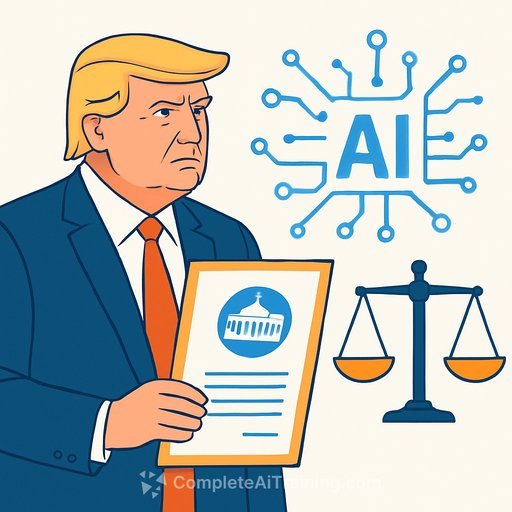Appian's GC Transition Meets AI Margin Caution: What Legal Teams Should Watch
On September 29, 2025, Appian said its General Counsel and Secretary, Christopher Winters, plans to retire in the fourth fiscal quarter, with a transition through November. The update landed as software stocks adjusted to market concern about AI and cloud profitability after disappointing cloud results at a large peer. For counsel, the signal is clear: governance, disclosure, and AI risk controls will be scrutinized alongside growth claims.
The legal relevance in plain terms
Executive transitions intersect with disclosure timing, insider controls, and continuity of legal oversight. At the same time, new AI features and pricing models raise data, IP, and compliance exposure that buyers and regulators will probe. Expect deeper diligence from enterprise customers on AI claims, training data provenance, and indemnities.
Disclosure and governance: immediate to-dos
- Form 8-K: Officer departure/appointment typically triggers Item 5.02 within four business days. Confirm timing, content, and any compensatory arrangements disclosures. See SEC Form 8-K instructions here.
- Risk factors and MD&A: Refresh commentary on AI monetization, cloud margin sensitivity, and competitive pressure in the next 10-Q/10-K.
- Reg FD and forward-looking statements: Align public AI statements and financial targets with safe-harbor language and internal substantiation.
- Insider trading controls: Maintain blackout periods and certify awareness of material nonpublic information during the transition.
- Board oversight: Document succession planning, AI governance responsibilities, and reporting lines during and after the GC change.
AI product rollout: legal checkpoints before scale
Appian's August launch of new AI-powered features underscores competitive positioning, but it also raises clear legal workstreams. Claims must be accurate, testable, and not misleading; the FTC has been explicit about overpromising AI capabilities. Their guidance is a useful benchmark for marketing reviews and compliance training link.
- Data and IP: Validate rights to training data, third-party models, and customer datasets; address residual learning and model improvement in contracts.
- Security and privacy: Map data flows, implement DPIAs where required, and align with cross-border transfer obligations.
- Bias and safety: Define evaluation metrics, document testing, and maintain audit trails. Prepare customer-facing attestations and certifications.
- Contracting: Calibrate warranties, SLA carve-outs for model behavior, caps, exclusions, and indemnities tied to AI outputs.
- Export controls and sector rules: Screen models and datasets for jurisdictional restrictions; track sector-specific requirements (financial services, health, public sector).
Financial context that shapes legal risk
The company's narrative projects 2028 revenue of $883.4 million and earnings of $115.6 million. That implies annual revenue growth of 10.3% and a $132.8 million improvement from a current loss of $17.2 million. One valuation framework points to $33.80 per share as a fair value estimate, about 19% above the recent price, while a set of community estimates spans roughly $18.54 to $33.80. Treat these as scenarios that influence disclosure and risk language, not as directives.
Procurement reality: what customers will ask legal
- Evidence behind AI performance claims and measurable ROI.
- Detailed data handling, retention, and deletion practices across model training and inference.
- Third-party model dependencies, update cadence, and SBOM-style transparency for AI components.
- Clear remedies for model errors, hallucinations, and compliance breaches.
Regulatory watchlist
- EU AI Act: High-risk use cases, transparency duties, and conformity assessments may affect sales cycles and documentation in the EU. Track applicability and phased timelines via the European Commission and local regulators.
- US oversight: SEC focus on AI-related disclosures and the FTC's stance on deceptive AI claims will shape public communications and marketing.
Checklist for in-house counsel and outside advisors
- Confirm GC succession plan, delegation of authority, and continuity of litigation, IP, and compliance portfolios.
- Run an AI product legal audit: claims review, data rights, safety testing, and incident response plans.
- Update standard customer contracts for AI-specific terms; align with sales enablement and RFP responses.
- Tighten disclosure controls around AI metrics, unit economics, and margin assumptions.
- Prepare board materials on AI risk posture, including model inventories and accountability owners.
What to watch next
- Details and timing of the incoming legal leader and any policy shifts.
- Customer adoption patterns for the new AI features and any pricing adjustments tied to compute costs.
- Competitive reactions and procurement feedback cycles that affect win rates and deal terms.
- Management commentary on AI profitability and cloud margins in the next earnings call.
This analysis is general and for information only. It is not financial advice and does not consider your objectives or situation. No position is held in any securities mentioned.
If your legal team is building practical AI governance skills and contract playbooks, explore curated learning by job role here.
Your membership also unlocks:






